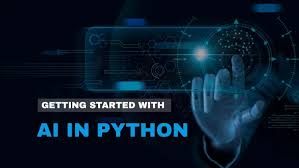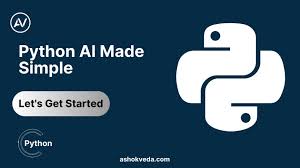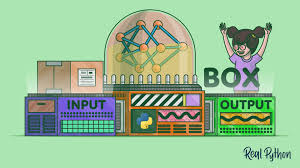How to Build Your First AI Model in Python:
Artificial Intelligence (AI) is no longer a thing of the future but it is being experienced today everywhere. Whether it is suggesting your next favourite tune or enabling self-driving vehicles, AI models have become cornerstone to the modern technology. But how can you really construct an AI model? Can one learn to do it in Python as a beginner? Absolutely.
And in this guide I will teach you how to create your first AI model in Python- step by step, even without being an expert to give it a try. We will go step by step on an example application that can be found in the real world and discuss the key concepts, as well as display how machine learning models operate with the help of simple code.
📌 What You’ll Learn:
-
What is an AI model?
-
Tools you need to get started (Python, libraries, IDE)
-
Step-by-step process to build your first model
-
Building a real AI model to predict housing prices
-
Common beginner mistakes and how to avoid them
🧠 What is an AI Model?
An Artificial intelligence model is a mathematical computation trained on data to make predictions or decisions. On machine learning (a field of AI), models use input data to learn the pattern and then use this information in new data (that have not been seen before).
Types of AI Models:
-
Supervised Learning: Learn from labeled data (e.g., spam vs. non-spam)
-
Unsupervised Learning: Discover hidden patterns in unlabeled data (e.g., clustering)
-
Reinforcement Learning: Learn by trial and error with rewards (e.g., game AI)
🛠️ Tools & Technologies You’ll Need
To build your first AI model in Python, you’ll need:
✅ 1. Python
A popular programming language known for its readability and strong AI ecosystem.
✅ 2. Libraries:
-
NumPy – For mathematical operations
-
Pandas – For data manipulation
-
Matplotlib/Seaborn – For data visualization
-
Scikit-learn – For building machine learning models
✅ 3. IDE (Integrated Development Environment)
You can use:
-
Jupyter Notebook (recommended for beginners)
-
Google Colab (browser-based, no setup)
-
VS Code or PyCharm
🏗️ Step-by-Step: Build a Simple AI Model
Let’s build a model that predicts housing prices based on features like area, number of bedrooms, etc. We’ll use a dataset and apply a Linear Regression algorithm from Scikit-learn.
🔹 Step 1: Install Required Libraries
If you haven’t already, install the following:
🔹 Step 2: Import the Libraries
🔹 Step 3: Load the Dataset
We’ll use a sample dataset (you can download from Kaggle or use synthetic data).
If you don’t have a dataset, you can use a built-in one:
🔹 Step 4: Explore the Data
🔹 Step 5: Prepare the Data
Separate features (X) and target variable (y):
Split data into training and testing sets:
🔹 Step 6: Build the Model
🔹 Step 7: Make Predictions
🔹 Step 8: Evaluate the Model
🔹 Step 9: Visualize Predictions
📚 Understanding What Just Happened
You trained a Linear Regression model to predict housing prices using California housing data. The model learned from training data and attempted to predict values for unseen (test) data. The R² score tells how well the model performs: 1 = perfect prediction, 0 = no prediction.
🚧 Common Mistakes Beginners Make
-
Feeding Bad Data: Clean your data before modeling.
-
Skipping Evaluation: Always check metrics to avoid overfitting/underfitting.
-
Using Too Many Features: More isn’t always better. Use feature selection.
-
Not Splitting Data: Never test your model on the data it trained on.
-
Ignoring Data Types: Convert categorical data into numerical (OneHotEncoding).
💡 Bonus: Tips for Better AI Projects
-
Use cross-validation for more reliable accuracy
-
Try other algorithms: Decision Trees, Random Forest, or Gradient Boosting
-
Visualize feature importance
-
Keep experimenting and tuning hyperparameters
🚀 What’s Next After Your First AI Model?
Now that you’ve built your first model, here’s where you can go:
| Next Step | Why It Matters |
|---|---|
| Learn classification models | Predict categories like spam/ham, sentiment, etc. |
| Try deep learning (using TensorFlow or PyTorch) | For image recognition, NLP, and more |
| Explore unsupervised learning | Find patterns without labeled data |
| Join Kaggle competitions | Practice with real-world datasets and feedback |
| Learn about MLOps | For deployment, monitoring, and scaling models |
🎯 Final Thoughts
Building your first AI model in Python might seem intimidating, but once you break it down into simple steps—data preparation, model training, evaluation—it becomes manageable and fun. Python, with its beginner-friendly syntax and powerful libraries, is the perfect place to start your AI journey.
Remember, the key to mastering AI is practice. Keep experimenting, tweak the models, and try different datasets. Over time, you’ll grow from a beginner into an AI pro.
📌 Summary Table
| Step | Description |
|---|---|
| Define the Problem | Predict house prices |
| Load the Data | Used California housing dataset |
| Split Data | Into training and testing sets |
| Train the Model | Used Linear Regression from Scikit-learn |
| Evaluate the Model | Used MSE and R² score |
| Visualize Predictions | Compared actual vs predicted prices |
How AI Is Transforming the World: Trends, Challenges, and Opportunities
The Rise of Autonomous AI Agents in Workflows: Altman’s 2025 Vision Becomes Reality
Multi-Agent Systems in Enterprise Software:The Future of Intelligent Business Operations





